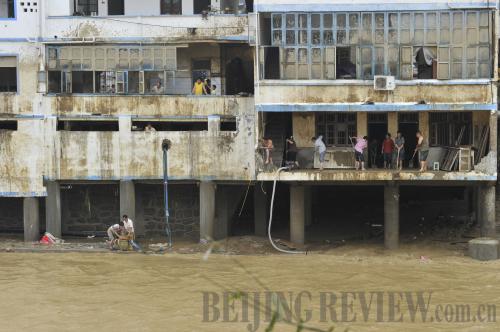|
 |
|
FIGHTING FLOODS: People in Wangmo County, Guizhou Province, clean up debris after a flood hit the county (LIU XU) |
Along the Yangtze River more than 40,000 reservoirs have been built, and 2,400 hydropower stations have been completed or are under construction, according to the Ministry of Water Resources. These power stations belong to different regions and are managed by different departments, so it's often difficult to adopt uniform controls. Since some hydropower facilities only consider their own interests, intensifying the conflict of water storage and discharge, said Zheng.
Some of the smaller local power stations are counterproductive to fighting droughts: In the dry season when the middle and lower reaches urgently need water, these power stations hold up and store large amounts of water to generate electricity. After strong rains, these small hydropower stations will discharge flood for their safety, intensifying the flood disasters. Uniform controls of these hydropower stations are urgently needed, Zheng said.
The Three Gorges Dam has also come under scrutiny in recent months as the Yangtze River region suffers from serious drought. Long-term observations will be needed, Zheng said, to rule on the dam's involvement.
Accelerating construction
To solve water shortage or surplus problems, a new irrigation and water conservancy mechanism must be established first, Zheng said. The mechanism—led by the central and provincial governments and complemented by governments at the county and township levels—would focus on irrigation and water conservancy infrastructure closely related to agricultural development and farmers' livelihoods.
Large-scale water conservancy projects would be funded by the Central Government, while basic irrigation and water conservancy facilities would be funded by provincial governments and built and maintained by county governments. Some small-scale infrastructure projects in rural communities would be mainly invested by farmers with government subsidies.
Opening new investment channels will also be crucial to the project's success since government funds will not be enough, Zheng said.
The government can raise funds in the capital market by issuing long-term treasury bonds. It can also set up special funds for construction on relevant projects. Zheng said if the government spends some money in establishing water conservancy funds, these funds will produce amplified effects in promoting the construction of water conservancy facilities, even though the funds only account for 0.5 percent of the GDP. The government can also encourage private capital to invest in irrigation and water conservancy infrastructure construction through tax incentives and favorable policies in acquiring loans.
China can also take a Western approach to financing and issue lotteries to raise funds. In developed countries such as the United States and Great Britain, the financing scale of issuing lotteries is huge and the money collected has been used to offer financial aid for public welfare programs.
China has successfully experimented with sports lotteries and welfare lotteries. Base on these experiences, China may be able to use lotteries as a means to finance its water conservancy undertaking.
Innovation needed
Increasing investment in water conservancy facilities is only part of the solution to China's water problem. The establishment of a new irrigation and water conservancy mechanism needs innovation. An accountability system targeted at local governments must be set up firstly, Zheng said.
Frequent droughts and floods in China are caused by the weather, but part of the blame for the after effects falls on local governments for inadequate preparation and response measures. They also have failed to attach enough importance to related construction projects, Zheng said. The key to this accountability system will be to put responsibility for drainage and storage projects on local officials.
Furthermore, establishing this system can also force local governments to invest a certain amount of funds they have available in small-scale irrigation and water conservancy construction.
According to Zheng, if Yunnan Province had spent 10 percent of the money equivalent to the total economic losses caused by the drought in improving irrigation and water conservancy facilities, the drought disaster would have been less severe. Inadequate input in water conservancy facilities and lack of reasonable water conservancy planning like this makes Yunnan, a province with annual precipitation of more than 1,000 millimeters, unable to find available water sources.
Another roadblock to expand China's water conservancy projects is the country's land contract system adopted in the late 1970s, which has made it difficult to organize large-scale irrigation and water conservancy construction, Zheng said.
There are a number of ways of solving this problem, Zheng said. Experience can be learned from construction projects undertaken by rural families before the contract system was adopted. An association of irrigation water users can also be formed, where the government offers aid for them to build water conservancy facilities.
"The ultimate goal is to make rural families participate in irrigation and water conservancy project construction and create a good mechanism for investment, construction, application and maintenance of infrastructure," he said. | 